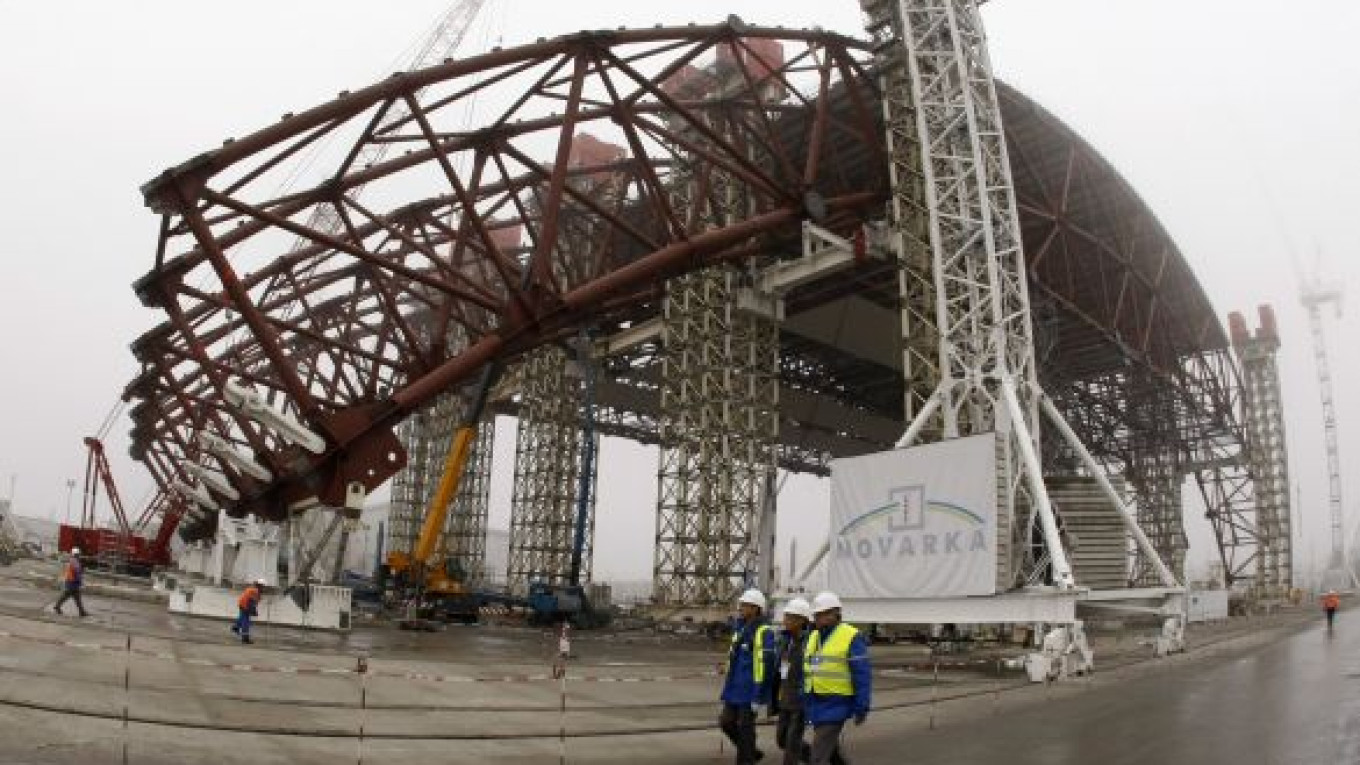CHERNOBYL NUCLEAR POWER STATION, Ukraine — Workers have raised the first section of a colossal arch-shaped structure that eventually will cover the exploded nuclear reactor at the Chernobyl power station.
Project officials on Tuesday hailed the raising as a significant step in a complex effort to clean up the consequences of the 1986 explosion, the world's worst nuclear accident. Upon completion, the shelter will be moved on tracks over the building containing the destroyed reactor, allowing workers to begin dismantling the reactor and dispose of radioactive waste.
Suma Chakrabati, president of the European Bank for Reconstruction and Development, which is leading the project, called the occurence "a very significant milestone [that] is a tribute to the ongoing commitment of the international donor community and an important step towards overcoming the legacy of the accident."
The shelter is shaped like a gargantuan Quonset hut. It will measure 257 meters by 150 meters when completed and at its apex will be higher than the Statue of Liberty.
The April 26, 1986, accident in the Soviet republic of Ukraine sent a cloud of radioactive fallout over much of Europe and forced the evacuation of about 115,000 people from the plant's vicinity.
A 30-kilometer area directly around the plant remains largely off-limits, and the town of Pripyat, where the plant's workers once lived, today is a ghostly ruin of deteriorating apartment towers.
At least 28 people died of acute radiation sickness from close exposure to the shattered reactor, and more than 6,000 cases of thyroid cancer have been detected in people who, as children or adolescents, were exposed to high levels of fallout after the blast.
Officials who showed reporters around the construction site Tuesday were clearly delighted at the colossus taking shape before them but also concerned about the challenges ahead.
The shelter is to be moved over the reactor building by the end of 2015, a deadline no one wants to miss given that the sarcophagus hastily built over the reactor building after the 1986 explosion has an estimated service life of about 30 years.
The arch now under construction is one of two segments that will eventually form the shelter, and so far it's been raised to a height of only 22 meters. More structural elements have to be added before it reaches its full height of 108 meters, and the work so far has taken seven months.
"There's no room for error. ... The schedule is very tight," said Vince Novak, director of the EBRD's nuclear safety department. He added that staying within budget is also a concern.
The overall project is budgeted at $2 billion. Of that amount, $1.3 billion is for the structure itself, and much uncertainty lies ahead.
One concern is demolition of the plant's chimney, which must be taken down before the shelter is put in place. The chimney is lined with radioactive residue that could break up and enter the atmosphere as it is taken apart.
Laurin Dodd, managing director of the project's management group, said some sort of fixative will have to be applied to the chimney's interior.
"This is one of the most challenging parts because it's an unknown," he said.
Other delays could come if excavation for the shelter's foundation uncovers radioactive waste or even buried machinery. Dodd said other excavations had unearthed several bulldozers and cranes, which had to be decontaminated.
Even when the shelter is in place, the area around the reactor building will remain hazardous. The shelter is intended to prevent radioactive material from escaping while the reactor is being dismantled. It won't block the actual radiation.
But when the dismantling and cleanup work is complete, the radiation danger will decline. How long that would take is unclear, but on Tuesday officials allowed themselves to envision a happier Chernobyl a century from now. The plant's director speculated that the huge shelter may even become a tourist attraction.
Plant director Igor Gramotkin drew a parallel between the shelter and the Eiffel Tower.
"Originally, that was intended to be destroyed," he said. "But I think this will be so impressive that even in 100 years people will come to look at it."
A Message from The Moscow Times:
Dear readers,
We are facing unprecedented challenges. Russia's Prosecutor General's Office has designated The Moscow Times as an "undesirable" organization, criminalizing our work and putting our staff at risk of prosecution. This follows our earlier unjust labeling as a "foreign agent."
These actions are direct attempts to silence independent journalism in Russia. The authorities claim our work "discredits the decisions of the Russian leadership." We see things differently: we strive to provide accurate, unbiased reporting on Russia.
We, the journalists of The Moscow Times, refuse to be silenced. But to continue our work, we need your help.
Your support, no matter how small, makes a world of difference. If you can, please support us monthly starting from just $2. It's quick to set up, and every contribution makes a significant impact.
By supporting The Moscow Times, you're defending open, independent journalism in the face of repression. Thank you for standing with us.
Remind me later.


